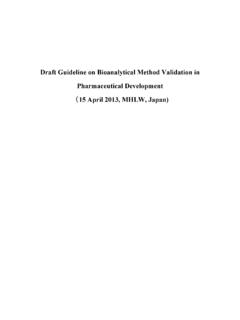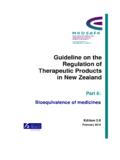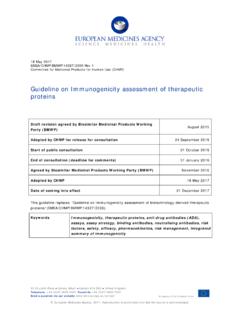Transcription of qualification and validation - נסיכת המדעים
1 Yossi Levy 2011 qualification and validation of analytical and bioanalytical methodsYossi Levy2 Method life cycleDevelopmentQualificationValidation Yossi Levy 20113 References ICH guidelines for validation of analytical methods : Q2A: Text on validation of analytical procedures Q2B: validation of analytical procedures: methodology ICH draft guideline 1033: Biological assay validation Consensus paper: Recommendations for the bioanalytical Method validation of Ligand-binding Assays to Support Pharmacokinetic Assessments of Macromolecules (2003), DeSilva et. al. Pharmaceutical Research, Vol. 20, No. 11, November 20034 Method development Exploratory process Early development phase check possibility of developing the method Optimization phase once development of method is possible, fine tuning of method s parameters is needed for efficient implementation Examples of parameters: temperature, incubation time, type of equipment, etc.
2 Statistical support is needed at the optimization phase Main statistical tool is DOE Usually, a series of controlled experiments is needed Yossi Levy 20115 qualification and validation qualification and validation are two steps in testing the performance of a (bio)analytical procedure/method and ensuring its quality qualification :A documented testing that demonstrates with a high degree of assurance that a specific process will meet its pre-determined acceptance criteria validation :A documented testing, performed under highly controlled conditions, which demonstrates a process consistently produces a result meeting pre-determined acceptance criteria6 What is the difference? Key difference: whether or not the process under review operates under 'highly controlled' conditions qualification can be viewed a less extensive form of validation Less parameters are checked Acceptation criteria are less strict In some cases, qualification is part of the method development process.
3 Method can be modified if necessary. Yossi Levy 20117 The role of the statistician To provide, in cooperation with the development team, the experimental design for the qualification / validation . To develop and write the statistical methods section or a statistical analysis plan as required for the qualification / validation . To analyze and report the qualification / validation results according to the predefined statistical methods . To review and approve the qualification / validation Selectivity/Specificity - the ability of an analytical method to differentiate and quantify the analyte in the presence of other components in the sample This includes: Identification ensuring the identity of the analyte Purity ensuring an accurate statement of the content of impurities of an analyte, related substances test, heavy metals, residual solvents content, etc. Assay (content or potency) - providing an exact result which allows an accurate statement on the content or potency of the analyte in a sample Yossi Levy 20119 Accuracy The accuracy of a (bio)analytical procedure expresses the closeness of agreement between the value which is accepted either as a conventional true value or an accepted reference value and the value found This is sometimes termed as trueness Accuracy is related to systematic error or bias10 Precision The precision of a (bio)analytical procedure expresses the closeness of agreement between a series of measurements obtained from multiple sampling of the same homogeneous sample under the prescribed conditions Precision is related to noise or variation Yossi Levy 201111 Accuracy vs.
4 Precision Accuracy=BiasPrecision=Variance12 Levels of precision Repeatabilityexpresses the precision under the same operating conditions over a short interval of time. Intermediateprecision expresses within-laboratories variations: different days, different analysts, different equipment, etc. Reproducibilityexpresses the precision between laboratories. Yossi Levy 201113 Other quality parameters Detection limit - the lowest amount of analyte in a sample which can be detected but not necessarily quantified as an exact value Quantification limit - the lowest amount of analyte in a sample which can be quantitatively determined with suitable precision and accuracy Linearity the ability (within a given range) to obtain test results which are directly proportional to the concentration (amount) of analyte in the sample14 Other quality parameters Range - the interval between the upper and lower concentration (amounts) of analyte in the sample (including these concentrations)
5 For which it has been demonstrated that the analytical procedure has a suitable level of precision, accuracy and linearity Robustness measuring the method s capacity to remain unaffected by small, but deliberate variations in method parameters Yossi Levy 201115 Precision and accuracy estimation"The way they do it at Chemistry accuracy and repeatability using 6 runs by the same analyst on the same day report reproducibility using another 6 runs by another analyst on another day report "Reproducibility Difference "16"The way they do it" advantage No experimental design No modeling No complex calculations Simple reporting Yossi Levy 201117"The way they do it" problems Biological methods are more complicated to implement, therefore the numbers of possible runs in a single day is limited Variation of biological methods is generally higher compared to chemical methods Measuring intermediate precision is not enabled No statistical sense18"The way they do it" Experimental Design Yossi Levy 201119 Example - Biological 1 Day/Analyst% ity Repeatabil= =% Differenceility Reproducib=+ =% =20 The way we would do it, at Statistics Mixed Model!
6 ,,cbijjiijcbY +++=Signal =random errorrandom effects+fixed parameter+ Independence Normal distribution Zero mean deviationsAssumptions: STDs: Yossi Levy 201121 Why use Mixed Models? Classical statistics assumes that observations are independent and identically distributed (iid) Often, data have a clustered structure When applied to clustered data, iid assumption may lead to false results Mixed Effects Model treats clustered data assumes two sources of variation, within cluster and between clusters This is the typical situation in biological data, when, observations are of the same biological category but individuals differ 22 Basic principles Two types of coefficients are distinguished in the mixed mode population-averaged: same meaning as in classical statistics Cluster/subject-specific: random; estimated as posteriori means Yossi Levy 201123 Formal modeling0),cov(),0(~),0(~=++= RNGNZXYRZZGVYV+ ==)(The matrices G and R are covariance matrices for the random effects and the random errors, respectively.
7 As a result:The trick is to find a good model for G24 SAS syntaxdataexample1;inputday y @@;cards;1 1 1 2 2 ;run;proc mixed method=reml covtest cl;classday;modely= / solution cl;randomday;run; Yossi Levy 201125 Example - SAS outputRepeatabilityBetween Day precisionAccuracy26 Results that make biological sense% ity Repeatabil= =% ility Reproducib=+ =% = Yossi Levy 201127 Results that make statistical sense 22 +D???? Days - - confidence intervalEstimateParameter28 DOE to measure intermediate precisions4 Days, 2 Analysts or2 Days, 4 Analysts Yossi Levy 201129 Reporting intermediate precisions =+ =+ = =100ityRepeatabil100 PrecisionAnalyst Between 100 PrecisionDay Between 100 Accuracy22 Analyst22 Day022 Analyst22 Dayfor CI , , ,++30 Example 2 AccuracyRepeatabilityBetween Day precisionBetween Analyst precision Yossi Levy 201131 Relative Standard Deviation Let X1.
8 Xn~N( , 2) iid. Define McKay derived the approximate distribution of RSD in 1932: This can be used to obtain CI for CV, but would one extend that to Mixed Models?XsRSDCV//== 32 Jackknife Idea: systematically re-computing the statistic estimate leaving out one or more observations at a time from the sample set From this new set of replicates of the statistic, an estimate for the bias and an estimate for the variance of the statistic can be calculated If we delete one observation at a time we get n sub-samples Then we calculate estimate CV out of the n subsamples, and obtain an estimate for it variation This estimate can be used to obtain a CI Yossi Levy 201133 Fieller s theorem application Same trick as in Fieller s theorem look at XCVsU = ThennCVnnCVsVUV22222)1(2)()( + = += The obtained CI is 34 Delta method Let Tnbe a MLE of a (multidimensional) parameter.
9 It is known that Tnis asymptotically Normally distributed: Consider a function h( ). We can expand its according to Taylor :()),0( NTnDn )()'()()( + nnThhTh Yossi Levy 201135 Delta method[][][][][ ])()'(1)()'()'())'()'()()()'()()( hhnhTVhThVhThhVThhVThVnnnnn == = == +== + 36 Application of Delta method In our framework:()()xyyxhXxnSSXT nininnnn/),()(1where,,12222= === = This leads to the following CI: Yossi Levy 201137 Parametric bootstrap38 Parametric bootstrap algorithm Estimate model parameters Simulate N new datasets based on estimated parameters Estimate parameter under interests for each of the simulated datasets to get a sample of N simulated estimates Use and sample quartiles as a CINote: for RSD, we use the 95% quartile as an upper confidence limit, since the lower confidence limit is zero. Yossi Levy 201139 Which method should we use?
10 We should consider Distributional assumptions are they correct? Are they needed? Robustness Ease of computation back calculation Can we calculate sample sizes?







